英语中的暗喻,明喻和拟人
- 格式:ppt
- 大小:160.50 KB
- 文档页数:9
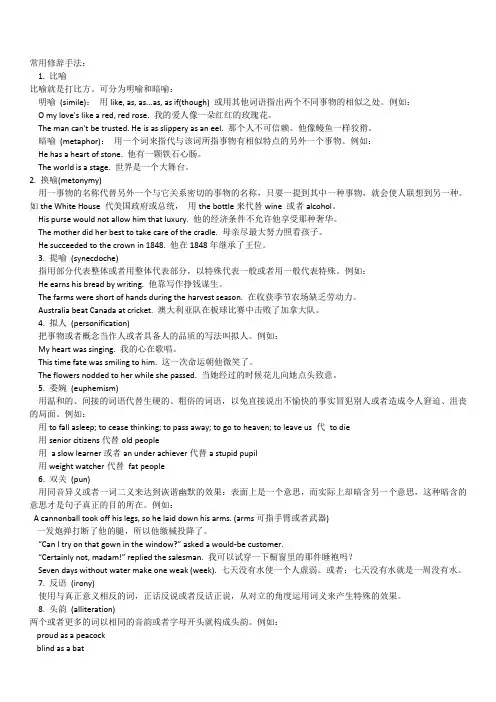
常用修辞手法:1. 比喻比喻就是打比方。
可分为明喻和暗喻:明喻(simile):用like, as, as...as, as if(though) 或用其他词语指出两个不同事物的相似之处。
例如:O my love's like a red, red rose. 我的爱人像一朵红红的玫瑰花。
The man can't be trusted. He is as slippery as an eel. 那个人不可信赖。
他像鳗鱼一样狡猾。
暗喻(metaphor):用一个词来指代与该词所指事物有相似特点的另外一个事物。
例如:He has a heart of stone. 他有一颗铁石心肠。
The world is a stage. 世界是一个大舞台。
2. 换喻(metonymy)用一事物的名称代替另外一个与它关系密切的事物的名称,只要一提到其中一种事物,就会使人联想到另一种。
如the White House 代美国政府或总统,用the bottle来代替wine 或者alcohol。
His purse would not allow him that luxury. 他的经济条件不允许他享受那种奢华。
The mother did her best to take care of the cradle. 母亲尽最大努力照看孩子。
He succeeded to the crown in 1848. 他在1848年继承了王位。
3. 提喻(synecdoche)指用部分代表整体或者用整体代表部分,以特殊代表一般或者用一般代表特殊。
例如:He earns his bread by writing. 他靠写作挣钱谋生。
The farms were short of hands during the harvest season. 在收获季节农场缺乏劳动力。
Australia beat Canada at cricket. 澳大利亚队在板球比赛中击败了加拿大队。
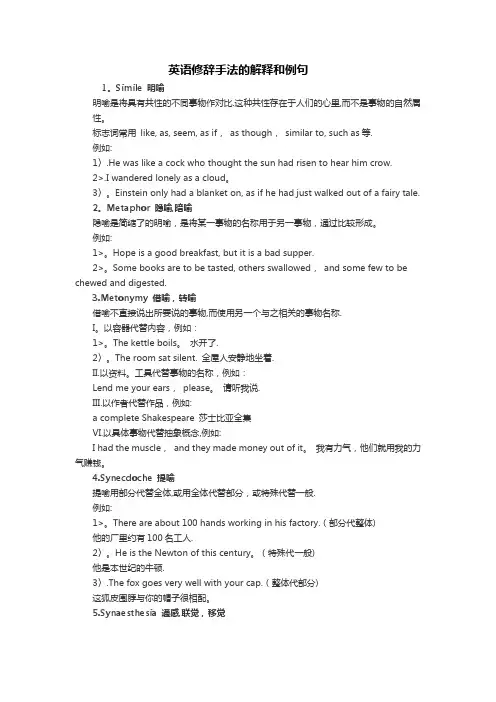
英语修辞手法的解释和例句1。
Simile 明喻明喻是将具有共性的不同事物作对比.这种共性存在于人们的心里,而不是事物的自然属性。
标志词常用like, as, seem, as if,as though,similar to, such as等.例如:1〉.He was like a cock who thought the sun had risen to hear him crow.2>.I wandered lonely as a cloud。
3〉。
Einstein only had a blanket on, as if he had just walked out of a fairy tale.2。
Metaphor 隐喻,暗喻隐喻是简缩了的明喻,是将某一事物的名称用于另一事物,通过比较形成。
例如:1>。
Hope is a good breakfast, but it is a bad supper.2>。
Some books are to be tasted, others swallowed,and some few to be chewed and digested.3.Metonymy 借喻,转喻借喻不直接说出所要说的事物,而使用另一个与之相关的事物名称.I。
以容器代替内容,例如:1>。
The kettle boils。
水开了.2〉。
The room sat silent. 全屋人安静地坐着.II.以资料。
工具代替事物的名称,例如:Lend me your ears,please。
请听我说.III.以作者代替作品,例如:a complete Shakespeare 莎士比亚全集VI.以具体事物代替抽象概念,例如:I had the muscle,and they made money out of it。
我有力气,他们就用我的力气赚钱。
4.Synecdoche 提喻提喻用部分代替全体,或用全体代替部分,或特殊代替一般.例如:1>。
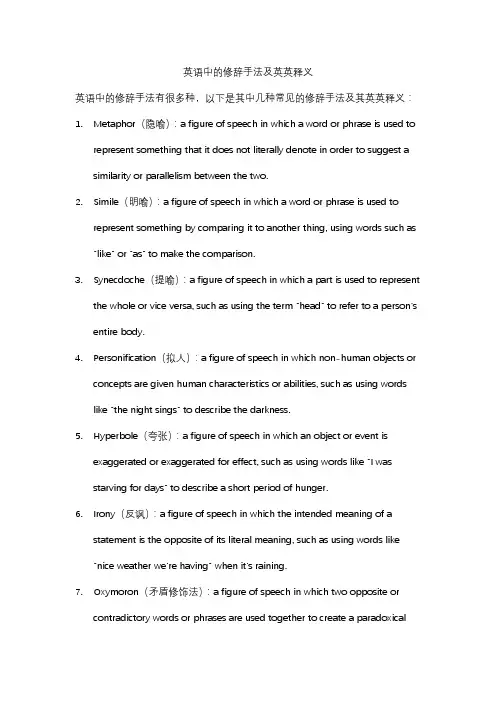
英语中的修辞手法及英英释义英语中的修辞手法有很多种,以下是其中几种常见的修辞手法及其英英释义:1.Metaphor(隐喻):a figure of speech in which a word or phrase is used torepresent something that it does not literally denote in order to suggest a similarity or parallelism between the two.2.Simile(明喻):a figure of speech in which a word or phrase is used torepresent something by comparing it to another thing, using words such as "like" or "as" to make the comparison.3.Synecdoche(提喻):a figure of speech in which a part is used to representthe whole or vice versa, such as using the term "head" to refer to a person's entire body.4.Personification(拟人):a figure of speech in which non-human objects orconcepts are given human characteristics or abilities, such as using words like "the night sings" to describe the darkness.5.Hyperbole(夸张):a figure of speech in which an object or event isexaggerated or exaggerated for effect, such as using words like "I wasstarving for days" to describe a short period of hunger.6.Irony(反讽):a figure of speech in which the intended meaning of astatement is the opposite of its literal meaning, such as using words like"nice weather we're having" when it's raining.7.Oxymoron(矛盾修饰法):a figure of speech in which two opposite orcontradictory words or phrases are used together to create a paradoxicaleffect, such as using words like "bittersweet" to describe a mixed feeling of happiness and sadness.这些修辞手法都可以增强语言的表达力,帮助传达更深刻的意义。
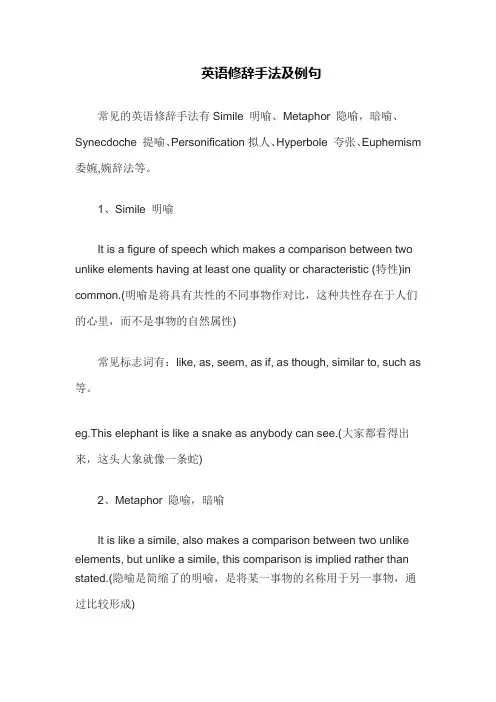
英语修辞手法及例句常见的英语修辞手法有Simile 明喻、Metaphor 隐喻,暗喻、Synecdoche 提喻、Personification拟人、Hyperbole 夸张、Euphemism 委婉,婉辞法等。
1、Simile 明喻It is a figure of speech which makes a comparison between two unlike elements having at least one quality or characteristic (特性)in common.(明喻是将具有共性的不同事物作对比,这种共性存在于人们的心里,而不是事物的自然属性)常见标志词有:like, as, seem, as if, as though, similar to, such as 等。
eg.This elephant is like a snake as anybody can see.(大家都看得出来,这头大象就像一条蛇)2、Metaphor 隐喻,暗喻It is like a simile, also makes a comparison between two unlike elements, but unlike a simile, this comparison is implied rather than stated.(隐喻是简缩了的明喻,是将某一事物的名称用于另一事物,通过比较形成)eg.Hope is a good breakfast, but it is a bad supper.(希望是顿美好的早餐,但却是一顿糟糕的晚餐。
)3 、Synecdoche 提喻It is involves the substitution of the part for the whole, or the whole for the part. (提喻用部分代替全体,或用全体代替部分,或特殊代替一般)eg.The fox goes very well with your cap. (这狐皮围脖与你的帽子很相配。
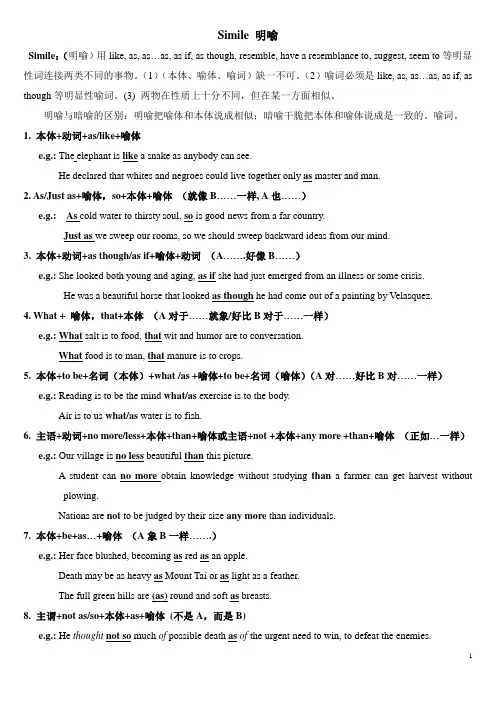
Simile 明喻Simile:(明喻)用like, as, as…as, as if, as though, resemble, have a resemblance to, suggest, seem to等明显性词连接两类不同的事物。
(1)(本体、喻体、喻词)缺一不可。
(2)喻词必须是like, as, as…as, as if, as though等明显性喻词。
(3) 两物在性质上十分不同,但在某一方面相似。
明喻与暗喻的区别:明喻把喻体和本体说成相似;暗喻干脆把本体和喻体说成是一致的。
喻词。
1. 本体+动词+as/like+喻体e.g.: The elephant is like a snake as anybody can see.He declared that whites and negroes could live together only as master and man.2. As/Just as+喻体,so+本体+喻体(就像B……一样, A也……)e.g.: As cold water to thirsty soul, so is good news from a far country.Just as we sweep our rooms, so we should sweep backward ideas from our mind.3. 本体+动词+as though/as if+喻体+动词(A…….好像B……)e.g.: She looked both young and aging, as if she had just emerged from an illness or some crisis.He was a beautiful horse that looked as though he had come out of a painting by Velasquez.4. What + 喻体,that+本体(A对于……就象/好比B对于……一样)e.g.: What salt is to food, that wit and humor are to conversation.What food is to man, that manure is to crops.5. 本体+to be+名词(本体)+what /as +喻体+to be+名词(喻体)(A对……好比B对……一样)e.g.: Reading is to be the mind what/as exercise is to the body.Air is to us what/as water is to fish.6. 主语+动词+no more/less+本体+than+喻体或主语+not +本体+any more +than+喻体(正如…一样)e.g.: Our village is no less beautiful than this picture.A student can no more obtain knowledge without studying than a farmer can get harvest withoutplowing.Nations are not to be judged by their size any more than individuals.7. 本体+be+as…+喻体(A象B一样…….)e.g.: Her face blushed, becoming as red as an apple.Death may be as heavy as Mount Tai or as light as a feather.The full green hills are (as) round and soft as breasts.8. 主谓+not as/so+本体+as+喻体(不是A,而是B)e.g.: He thought not so much of possible death as of the urgent need to win, to defeat the enemies.e.g.: Right now, it is not their accountants who are holding the companies back so much as their legaladvisers.9. 主语+may/might +as well+动词+喻体+as+动词+本体(……不如…; …最好…; …还是…好)e.g.: You may as well advise me to give up my fortune as my argument.你劝我停止辩论还不如劝我抛弃我的财产。
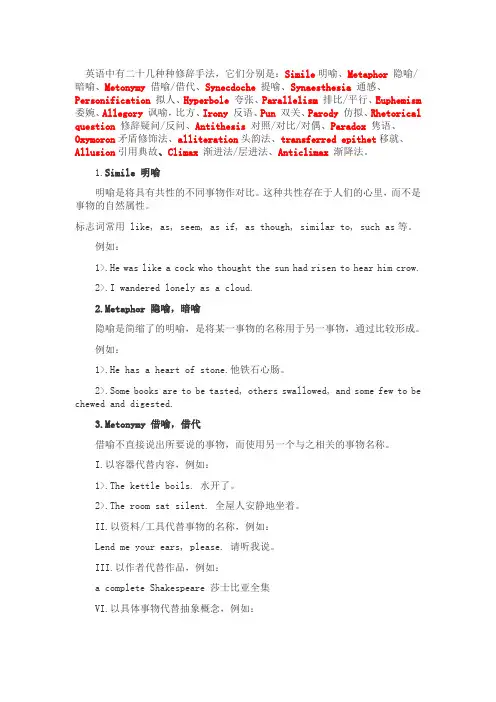
英语中有二十几种种修辞手法,它们分别是:Simile明喻、Metaphor隐喻/暗喻、Metonymy借喻/借代、Synecdoche提喻、Synaesthesia 通感、Personification拟人、Hyperbole夸张、Parallelism排比/平行、Euphemism 委婉、Allegory 讽喻,比方、Irony反语、Pun双关、Parody仿拟、Rhetorical question修辞疑问/反问、Antithesis对照/对比/对偶、Paradox隽语、Oxymoron矛盾修饰法、alliteration头韵法、transferred epithet移就、Allusion引用典故、Climax渐进法/层进法、Anticlimax渐降法。
1.Simile 明喻明喻是将具有共性的不同事物作对比。
这种共性存在于人们的心里,而不是事物的自然属性。
标志词常用 like, as, seem, as if, as though, similar to, such as等。
例如:1>.He was like a cock who thought the sun had risen to hear him crow.2>.I wandered lonely as a cloud.2.Metaphor 隐喻,暗喻隐喻是简缩了的明喻,是将某一事物的名称用于另一事物,通过比较形成。
例如:1>.He has a heart of stone.他铁石心肠。
2>.Some books are to be tasted, others swallowed, and some few to be chewed and digested.3.Metonymy 借喻,借代借喻不直接说出所要说的事物,而使用另一个与之相关的事物名称。
I.以容器代替内容,例如:1>.The kettle boils. 水开了。
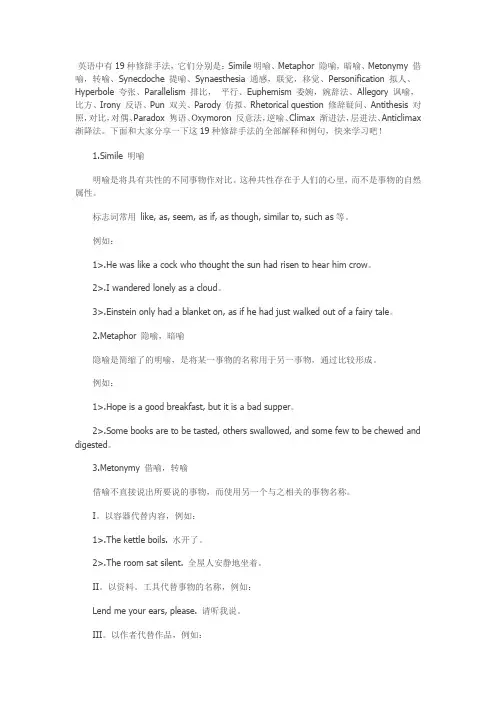
英语中有19种修辞手法,它们分别是:Simile明喻、Metaphor 隐喻,暗喻、Metonymy 借喻,转喻、Synecdoche 提喻、Synaesthesia 通感,联觉,移觉、Personification 拟人、Hyperbole 夸张、Parallelism 排比,平行、Euphemism 委婉,婉辞法、Allegory 讽喻,比方、Irony 反语、Pun 双关、Parody 仿拟、Rhetorical question 修辞疑问、Antithesis 对照,对比,对偶、Paradox 隽语、Oxymoron 反意法,逆喻、Climax 渐进法,层进法、Anticlimax 渐降法。
下面和大家分享一下这19种修辞手法的全部解释和例句,快来学习吧!1.Simile 明喻明喻是将具有共性的不同事物作对比。
这种共性存在于人们的心里,而不是事物的自然属性。
标志词常用like, as, seem, as if, as though, similar to, such as等。
例如:1>.He was like a cock who thought the sun had risen to hear him crow。
2>.I wandered lonely as a cloud。
3>.Einstein only had a blanket on, as if he had just walked out of a fairy tale。
2.Metaphor 隐喻,暗喻隐喻是简缩了的明喻,是将某一事物的名称用于另一事物,通过比较形成。
例如:1>.Hope is a good breakfast, but it is a bad supper。
2>.Some books are to be tasted, others swallowed, and some few to be chewed and digested。
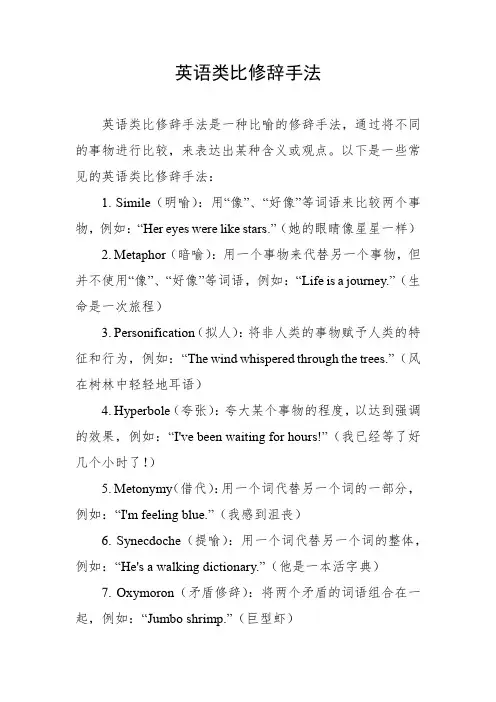
英语类比修辞手法
英语类比修辞手法是一种比喻的修辞手法,通过将不同的事物进行比较,来表达出某种含义或观点。
以下是一些常见的英语类比修辞手法:
1. Simile(明喻):用“像”、“好像”等词语来比较两个事物,例如:“Her eyes were like stars.”(她的眼睛像星星一样)
2. Metaphor(暗喻):用一个事物来代替另一个事物,但并不使用“像”、“好像”等词语,例如:“Life is a journey.”(生命是一次旅程)
3. Personification(拟人):将非人类的事物赋予人类的特征和行为,例如:“The wind whispered through the trees.”(风在树林中轻轻地耳语)
4. Hyperbole(夸张):夸大某个事物的程度,以达到强调的效果,例如:“I've been waiting for hours!”(我已经等了好几个小时了!)
5. Metonymy(借代):用一个词代替另一个词的一部分,例如:“I'm feeling blue.”(我感到沮丧)
6. Synecdoche(提喻):用一个词代替另一个词的整体,例如:“He's a walking dictionary.”(他是一本活字典)
7. Oxymoron(矛盾修辞):将两个矛盾的词语组合在一起,例如:“Jumbo shrimp.”(巨型虾)
这些英语类比修辞手法可以帮助作者更生动地表达自己的思想,并使文章更具吸引力和说服力。
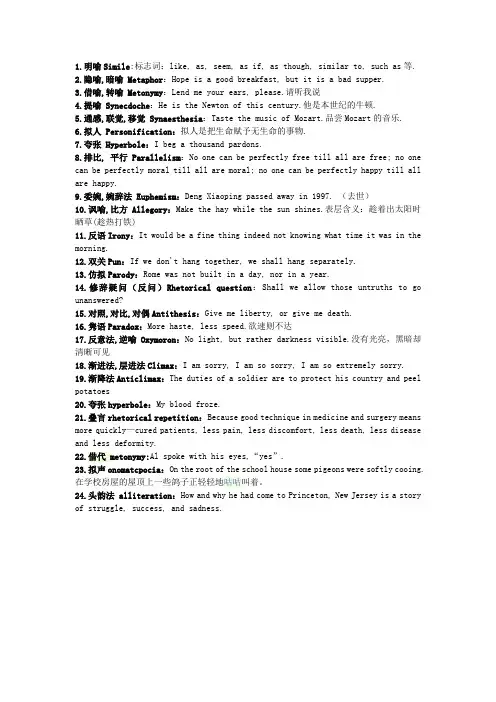
1.明喻Simile:标志词:like, as, seem, as if, as though, similar to, such as等.2.隐喻,暗喻 Metaphor:Hope is a good breakfast, but it is a bad supper.3.借喻,转喻 Metonymy:Lend me your ears, please.请听我说4.提喻 Synecdoche:He is the Newton of this century.他是本世纪的牛顿.5.通感,联觉,移觉 Synaesthesia:Taste the music of Mozart.品尝Mozart的音乐.6.拟人 Personification:拟人是把生命赋予无生命的事物.7.夸张 Hyperbole:I beg a thousand pardons.8.排比, 平行 Parallelism:No one can be perfectly free till all are free; no one can be perfectly moral till all are moral; no one can be perfectly happy till all are happy.9.委婉,婉辞法 Euphemism:Deng Xiaoping passed away in 1997. (去世)10.讽喻,比方Allegory:Make the hay while the sun shines.表层含义:趁着出太阳时晒草(趁热打铁)11.反语Irony:It would be a fine thing indeed not knowing what time it was in the morning.12.双关Pun:If we don't hang together, we shall hang separately.13.仿拟Parody:Rome was not built in a day, nor in a year.14.修辞疑问(反问)Rhetorical question:Shall we allow those untruths to go unanswered?15.对照,对比,对偶Antithesis:Give me liberty, or give me death.16.隽语Paradox:More haste, less speed.欲速则不达17.反意法,逆喻Oxymoron:No light, but rather darkness visible.没有光亮,黑暗却清晰可见18.渐进法,层进法Climax:I am sorry, I am so sorry, I am so extremely sorry.19.渐降法Anticlimax:The duties of a soldier are to protect his country and peel potatoes20.夸张hyperbole:My blood froze.21.叠言rhetorical repetition:Because good technique in medicine and surgery means more quickly—cured patients, less pain, less discomfort, less death, less disease and less deformity.22.借代metonymy:A l spoke with his eyes,“yes”.23.拟声onomatcpocia:On the root of the school house some pigeons were softly cooing.在学校房屋的屋顶上一些鸽子正轻轻地咕咕叫着。
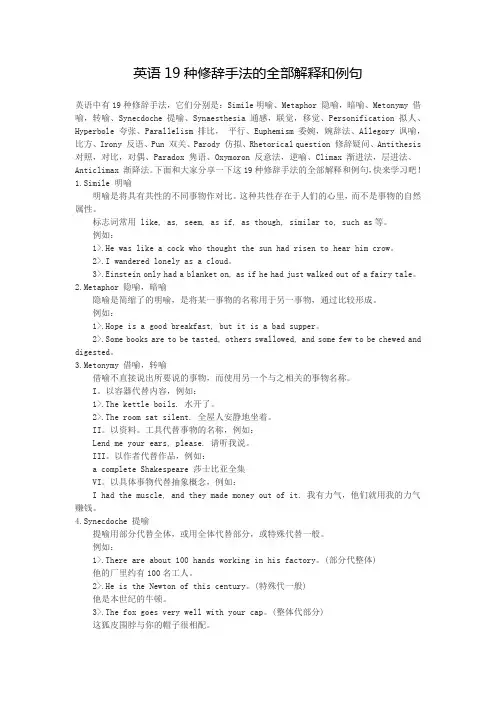
英语19种修辞手法的全部解释和例句英语中有19种修辞手法,它们分别是:Simile明喻、Metaphor 隐喻,暗喻、Metonymy 借喻,转喻、Synecdoche 提喻、Synaesthesia 通感,联觉,移觉、Personification 拟人、Hyperbole 夸张、Parallelism 排比,平行、Euphemism 委婉,婉辞法、Allegory 讽喻,比方、Irony 反语、Pun 双关、Parody 仿拟、Rhetorical question 修辞疑问、Antithesis 对照,对比,对偶、Paradox 隽语、Oxymoron 反意法,逆喻、Climax 渐进法,层进法、Anticlimax 渐降法。
下面和大家分享一下这19种修辞手法的全部解释和例句,快来学习吧!1.Simile 明喻明喻是将具有共性的不同事物作对比。
这种共性存在于人们的心里,而不是事物的自然属性。
标志词常用 like, as, seem, as if, as though, similar to, such as等。
例如:1>.He was like a cock who thought the sun had risen to hear him crow。
2>.I wandered lonely as a cloud。
3>.Einstein only had a blanket on, as if he had just walked out of a fairy tale。
2.Metaphor 隐喻,暗喻隐喻是简缩了的明喻,是将某一事物的名称用于另一事物,通过比较形成。
例如:1>.Hope is a good breakfast, but it is a bad supper。
2>.Some books are to be tasted, others swallowed, and some few to be chewed and digested。
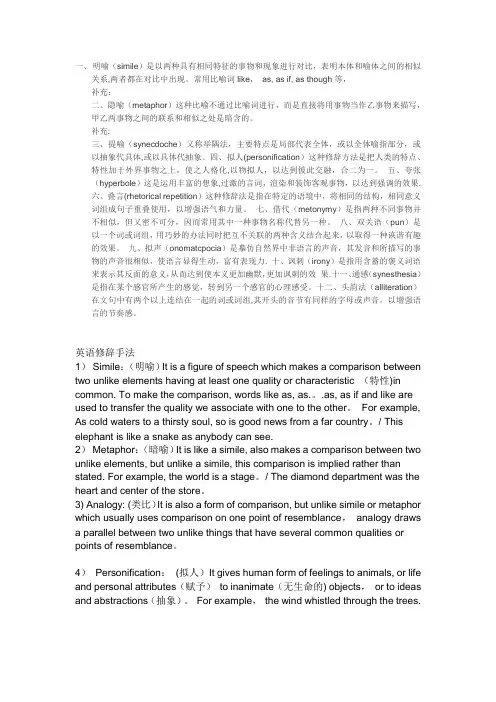
一、明喻(simile)是以两种具有相同特征的事物和现象进行对比,表明本体和喻体之间的相似关系,两者都在对比中出现。
常用比喻词like,as, as if, as though等,补充:二、隐喻(metaphor)这种比喻不通过比喻词进行,而是直接将用事物当作乙事物来描写,甲乙两事物之间的联系和相似之处是暗含的。
补充:三、提喻(synecdoche)又称举隅法,主要特点是局部代表全体,或以全体喻指部分,或以抽象代具体,或以具体代抽象。
四、拟人(personification)这种修辞方法是把人类的特点、特性加于外界事物之上,使之人格化,以物拟人,以达到彼此交融,合二为一。
五、夸张(hyperbole)这是运用丰富的想象,过激的言词,渲染和装饰客观事物,以达到强调的效果.六、叠言(rhetorical repetition)这种修辞法是指在特定的语境中,将相同的结构,相同意义词组成句子重叠使用,以增强语气和力量。
七、借代(metonymy)是指两种不同事物并不相似,但又密不可分,因而常用其中一种事物名称代替另一种。
八、双关语(pun)是以一个词或词组,用巧妙的办法同时把互不关联的两种含义结合起来,以取得一种诙谐有趣的效果。
九、拟声(onomatcpocia)是摹仿自然界中非语言的声音,其发音和所描写的事物的声音很相似,使语言显得生动,富有表现力. 十、讽刺(irony)是指用含蓄的褒义词语来表示其反面的意义,从而达到使本义更加幽默,更加讽刺的效果.十一、通感(synesthesia)是指在某个感官所产生的感觉,转到另一个感官的心理感受。
十二、头韵法(alliteration)在文句中有两个以上连结在一起的词或词组,其开头的音节有同样的字母或声音,以增强语言的节奏感。
英语修辞手法1)Simile:(明喻)It is a figure of speech which makes a comparison between two unlike elements having at least one quality or characteristic (特性)in common. To make the comparison, words like as, as.。
英语语法:英语的19种修辞手法分析英语中有19种修辞手法分别是:Simile明喻、Metaphor 隐喻,暗喻、Metonymy 借喻,转喻、Synecdoche 提喻、Synaesthesia 通感,联觉,移觉、Personification 拟人、Hyperbole 夸张、Parallelism 排比,平行、Euphemism 委婉,婉辞法、Allegory 讽喻,比方、Irony 反语、Pun 双关、Parody 仿拟、Rhetorical question 修辞疑问、Antithesis 对照,对比,对偶、Paradox 隽语、Oxymoron 反意法,逆喻、Climax 渐进法,层进法、Anticlimax 渐降法。
英语的19种修辞手法具体用法:1.Simile 明喻明喻是将具有共性的不同事物作对比。
这种共性存在于人们的心里,而不是事物的自然属性。
标志词常用 like, as, seem, as if, as though, similar to, such as 等。
例如:1.He was like a cock who thought the sun had risen to hear him crow。
2.I wandered lonely as a cloud。
3.Einstein only had a blanket on, as if he had just walked out ofa fairy tale。
2.Metaphor 隐喻,暗喻隐喻是简缩了的明喻,是将某一事物的名称用于另一事物,通过比较形成。
例如:1.Hope is a good breakfast, but it is a bad supper。
2.Some books are to be tasted, others swallowed, and some few to be chewed and digested。
英语修辞大全,英语作文常用修辞手法Rhetoric 修辞文章最忌语言枯燥无味,一篇好的作文,语言应该生动形象。
而恰当地运用修辞手法,可以使文字新鲜活泼、具体逼真,大大增强艺术表现力,扩大语言表达的范围;而且还可以激发读者的想象,给人留下深刻的印象。
下面介绍一些英语作文中常用的修辞手法。
1. 比喻(metaphor)比喻就是打比方。
可分为明喻和暗喻:明喻(simile):A figure of speech in which two essentially unlike things are compared. 明喻:一种修辞手法,把两种基本不相像的东西进行比较.用like, as, as...as, as if(though) 或用其他词语指出两个不同事物的相似之处。
例如:“How like the winter hath my absence been” or “So are you to my thoughts as food to life” (Shakespeare). 如“我的离开好象是冬天来临” 或“你对我的思想就象食物对于生命一样重要” (莎士比亚)O my love's like a red, red rose. 我的爱人像一朵红红的玫瑰花。
The man can't be trusted. He is as slippery as an eel. 那个人不可信赖。
他像鳗鱼一样狡猾。
He jumped as if he had been stung.他像被蜇了似的跳了起来。
Childhood is like a swiftly passing dream. 童年就像一场疾逝的梦。
暗喻(metaphor):缩写met.,metaph. A figure of speech in which a word or phrase that ordinarily designates one thing is used to designate another, thus making an implicit comparison.用一个词来指代与该词所指事物有相似特点的另外一个事物。
英语19种修辞手法的全部解释和例句修辞是能够让语言变得更加富有表达性的工具,同时也是让语言变得更加复杂的一种语言现象,了解修辞手法,能够让我们更加容易了解作者或者说话者想要来表达的情感和想法。
英语和汉语一样,也有着丰富的修辞手法。
今天我们来了解一下英语中的修辞手法,帮助我们更好的学习英语。
英语中有19种修辞手法,它们分别是:Simile明喻、Metaphor隐喻,暗喻、Metonymy借喻,转喻、Synecdoche 提喻、Synaesthesia通感,联觉,移觉、Personification拟人、Hyperbole夸张、Parallelism排比,平行、Euphemism委婉,婉辞法、Allegory讽喻,比方、Irony反语、Pun双关、Parody仿拟、Rhetoricalquestion修辞疑问、Antithesis对照,对比,对偶、Paradox隽语、Oxymoron反意法,逆喻、Climax渐进法,层进法、Anticlimax渐降法。
下面和大家一一介绍一下这19种修辞手法,同时也给出全部解释和例句:1、Simile明喻明喻是将具有共性的不同事物作对比.这种共性存在于人们的心里,而不是事物的自然属性. 标志词常用like,as,seem,as if,as though,similar to,such as 等. 例如: 1>.He was like a cock who thought the sun had risen to hear him crow. 2>.I wan dered lonely as a cloud. 3>.Einstein only had a blanket on, as if he had just walked ou t of a fairy tale.2.Metaphor隐喻,暗喻隐喻是简缩了的明喻,是将某一事物的名称用于另一事物,通过比较形成. 例如: 1>.Hope is a good breakfast, but it is a bad supper. 2>.Some books are to be taste d, others swallowed, and some few to be chewed and digested.3.Metonymy借喻,转喻借喻不直接说出所要说的事物,而使用另一个与之相关的事物名称. I.以容器代替内容,例如: 1>.The kettle boils. 水开了. 2>.The room sat silent. 全屋人安静地坐着. II.以资料.工具代替事物的名称,例如: Lend me your ears, please. 请听我说. III.以作者代替作品,例如: a complete Shakespeare 莎士比亚全集 VI.以具体事物代替抽象概念,例如: I had the muscle, and they made money out of it.我有力气,他们就用我的力气赚钱.4.Synecdoche提喻提喻用部分代替全体,或用全体代替部分,或特殊代替一般. 例如: 1>.There are about 100 hands working in his factory.(部分代整体) 他的厂里约有100名工人. 2>.He is the Newton of this century.(特殊代一般) 他是本世纪的牛顿. 3>.The fox goes very well with your cap.(整体代部分) 这狐皮围脖与你的帽子很相配.5.Synaesthesia通感,联觉,移觉这种修辞法是以视.听.触.嗅.味等感觉直接描写事物.通感就是把不同感官的感觉沟通起来,借联想引起感觉转移,“以感觉写感觉”。
英语中所有19种修辞手法的全部解释和例句拟声onomatopoeia,头韵alliteration,半韵assonance,移就transferred epithet,圆周句periodic sentences,反复repetition,倒装inversion,延喻 extended metaphor,共轭zeugma,嘲讽 ridicule 典故allusion1.Simile 明喻明喻是将具有共性的不同事物作对比.这种共性存在于人们的心里,而不是事物的自然属性.标志词常用 like, as, seem, as if, as though, similar to, such as等.例如:1>.He was like a cock who thought the sun had risen to hear him crow.2>.I wandered lonely as a cloud.3>.Einstein only had a blanket on, as if he had just walked out of a fairy tale.2.Metaphor 隐喻,暗喻隐喻是简缩了的明喻,是将某一事物的名称用于另一事物,通过比较形成.例如:1>.Hope is a good breakfast, but it is a bad supper.2>.Some books are to be tasted, others swallowed, and some few to be chewed and digested.3.Metonymy 借喻,转喻[mɪ'tɒnɪmɪ]借喻不直接说出所要说的事物,而使用另一个与之相关的事物名称.I.以容器代替内容,例如:1>.The kettle boils. 水开了.2>.The room sat silent. 全屋人安静地坐着.II.以资料.工具代替事物的名称,例如:Lend me your ears, please. 请听我说.III.以作者代替作品,例如:a complete Shakespeare 莎士比亚全集VI.以具体事物代替抽象概念,例如:I had the muscle, and they made money out of it. 我有力气,他们就用我的力气赚钱.4.Synecdoche 提喻[sɪ'nekdəkɪ]提喻用部分代替全体,或用全体代替部分,或特殊代替一般.例如:1>.There are about 100 hands working in his factory.(部分代整体)他的厂里约有100名工人.2>.He is the Newton of this century.(特殊代一般)他是本世纪的牛顿.3>.The fox goes very well with your cap.(整体代部分)这狐皮围脖与你的帽子很相配.5.Synaesthesia 通感,联觉,移觉[,sɪnɪs'θiːzɪə]这种修辞法是以视.听.触.嗅.味等感觉直接描写事物.通感就是把不同感官的感觉沟通起来,借联想引起感觉转移,“以感觉写感觉”。
1.明喻(Simile)明喻(Simile),是常用as或like等词将具有某种共同特征的两种不同事物连接起来的一种修辞手法。
明喻的表达方法是:A像B。
以两件基本上不相同的事物作比喻的修辞手段。
比喻的一种,明显地用另外的事物来比拟某事物,表示两者之间的相似关系。
常用“如”、“像”、“似”、“好像”、“像…似的”、“如同”、“好比”等比喻词。
通常有三部分构成:本体、喻体、比喻词例如:My heart is like a singing bird.(我的心像一只歌唱的小鸟。
)O my love's like a red, red rose,That's newly sprung in June;That's sweetly played in tune.2.隐喻,暗喻(Metaphor)隐喻也称暗喻,是用一个词来指代与该词本来所指事物有相似特点的另一个事物的方法。
隐喻是和明喻不同,不用like或as表示出来,而是进行隐藏的比较的这样一种修辞手段。
隐喻又称暗喻。
表达方法:A是B。
隐喻是一种比喻,用一种事物暗喻另一种事物。
隐喻是在彼类事物的暗示之下感知、体验、想象、理解、谈论此类事物的心理行为、语言行为和文化行为。
就本体和喻体的关系而言,隐喻比明喻更为紧密。
从语意的角度分析,隐喻比明喻深奥、更形象、更有喻示性和渗透力。
名词、动词、形容词和副词都可以有隐喻用法。
例如: 1.He is a pig.他简直是头猪。
(比喻:他是一个像猪一般的人,指肮脏,贪吃的人。
)2.She is a woman with a stony heart.她是一个铁石心肠的女人。
(比喻:这个女人冷酷无情。
)3.Mark Twain is a mirror of America.马克·吐温是美国的一面镜子。
(用镜子比喻美国的现实,很贴切。
)在一篇描绘中东市场的文章中,作者在描绘其中的铜器市场中燃烧着的木炭时这样写道: “the red of the live coals glowing,bright and then dimming rhythmically to the strokes of the bellows”。